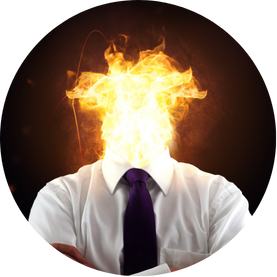Pain is not just a signal from tissue – it is an experience that the brain constructs. In this process, nociceptiontransmission of tissue stimuli to the central nervous system, affectfelt evaluation, e.g., unpleasantness, cognitionthoughts, expectations, evaluation, and attention intermingle. Imaginationthe conscious creation of sensory images without external stimulus can intervene in this construction. For example, when someone imagines a protective glove, different networks are activated compared to someone who imagines a wound. Motor imagerythe mental execution of movements without actual movement additionally addresses the motor system and can retrain pain-related avoidance programs. Progressive muscle relaxation (PMR)systematic tensing and relaxing of muscle groups to reduce baseline tone lowers physical alertness, while biofeedbackreal-time feedback of physiological signals such as heart rate, skin conductance makes unconscious tensions visible and trainable. The fundamental principle is that mental content modulates the evaluation of stimuli and thereby the intensity of pain – ideally quickly, specifically, and without side effects.
Targeted imagination can dampen acute and chronic pain by redirecting attention and altering evaluation processes. In controlled experiments, the image of a “protective glove” reduced perceived intensity spikes and the unpleasantness of pain stimuli; conversely, threatening images intensified the pain – the content determines the direction and strength of the effect [1]. In chronic pain, the psyche is not a mere side show: individuals with distressing pain perceptions report more anxiety, depression, and catastrophizing – factors that exacerbate pain and hinder recovery [2]. This underscores that imagination is a double-edged sword; it must be purposefully trained, ideally embedded in active strategies such as movement and attention training. When the mental simulation of pain-free movements is combined with conventional physiotherapy, improvements in pain and function, for example in knee pain, are measurable [3]. Additionally, mind-body interventions such as PMR, mindfulness, hypnosis, and biofeedback show positive effects in practice for chronic pain, especially when provided in a structured manner [Ref23529519; Ref9487625].
In an EEG study, participants trained to dampen or intensify pain using targeted images. With the “glove” image, pain intensity and unpleasantness decreased, sensory stimuli were less frequently classified as “painful,” and early cortical processing signals (N2) changed in regions responsible for inhibitory control and semantic retrieval; threatening images, on the other hand, activated networks for salience and emotional regulation [1]. These findings show that imagination not only alters attention but also intervenes in decision-making and evaluation processes – with rapid, measurable brain signatures. Clinically relevant is also what can go wrong: in a survey of people with chronic pain, the presence of distressing pain images was associated with higher anxiety, depression, and catastrophizing, with no difference in physical disability [2]. This suggests that unfavorable imagination amplifies emotional burdens and should be actively addressed, for instance, through reframing or therapeutic guidance. Finally, randomized studies on motor imagery and action observation in knee pain consolidate the evidence: as an adjunct to physiotherapy, these “Movement Representation” techniques improved both pain and function, meta-analytically with a significant effect [3]. Together with practical overviews on PMR, guided imagery, and biofeedback, a consistent picture emerges: mental techniques work – best in a structured, combined application [Ref23529519; Ref9487625].
- Make guided imagery a daily micro-routine: 2–5 minutes, 2–3 times a day. Choose a neutral or protective image (e.g., “warming glove,” “cooling stream”) and couple it with the situation in which pain typically occurs. Track the change in pain intensity on a 0–10 scale to find your personal “image code” [1].
- Combine progressive muscle relaxation with imagery: tense and relax your feet, legs, torso, shoulders, hands, and face one after the other for about 5–7 seconds each, breathe out calmly, and immediately place your chosen protective image over the affected area. This sequence lowers the baseline tone and enhances the imagery effect [4].
- Train motor simulation of precise movements: visualize 3–5 repetitions of the pain-relevant movement in perfect, pain-free quality (e.g., squat with proper alignment, relaxed breathing). Then gradually increase the real movement. Use mental rehearsals even between sets. Evidence shows benefits for pain reduction and functional improvement, especially in combination with physiotherapy [3].
- Complement with biofeedback: Use heart rate variability apps or devices for skin conductance/EMG to recognize tension. Lower the values through slow exhalation (e.g., 4–6 breaths per minute) and overlay your protective image. This way, you learn to deliberately reduce physiological arousal and smooth pain peaks [5].
- Avoid going solo without the body: Do not use imagination as a substitute for movement. Integrate it into an active program of strength, mobility, and endurance – purely mental strategies without physical activation often fall short of their potential [6].
- Be aware of psychological side effects: If distressing pain images (catastrophe scenarios) arise, consciously work with reframing or seek therapeutic guidance. This reduces anxiety and prevents imagination from unintentionally amplifying pain [2].
The next generation of pain therapy combines neurocognitive tools with targeted movement and real-time data from biofeedback. Personalized protocols are expected to derive your best “protective image” and optimal breathing frequency from brain and body signals. With growing evidence, mental simulation, PMR, and smart sensor technology are becoming a practical set for less pain and more performance.
This health article was created with AI support and is intended to help people access current scientific health knowledge. It contributes to the democratization of science – however, it does not replace professional medical advice and may present individual details in a simplified or slightly inaccurate manner due to AI-generated content. HEARTPORT and its affiliates assume no liability for the accuracy, completeness, or applicability of the information provided.













